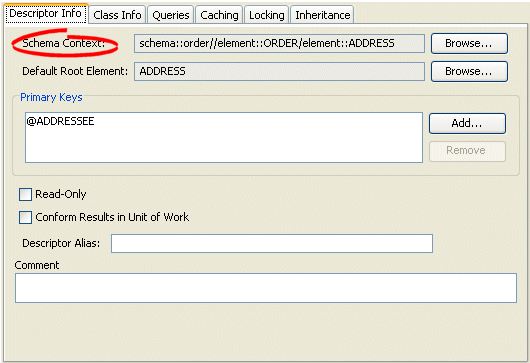|
Oracle TopLink Developer's Guide
10g Release 3 (10.1.3) B13593-01 |
|
 Previous |
 Next |
|
Oracle TopLink Developer's Guide
10g Release 3 (10.1.3) B13593-01 |
|
 Previous |
 Next |
TopLink Workbench uses the schema context to associate the class that the EIS descriptor describes with a simple or complex type in one of the schemas associated with the EIS project (see "Configuring XML Schema Reference"). This allows TopLink Workbench to display the appropriate attributes available for mapping in that context.
You must configure the schema context for an EIS root descriptor (see "Configuring an EIS Descriptor as a Root or Composite Type") only if you are using TopLink Workbench.
To associate an EIS descriptor with a simple or complex type in this project's schema, use this procedure:
Select an EIS descriptor in the Navigator. Its properties appear in the Editor.
Click the Descriptor Info tab. The Descriptor Info tab appears.
Figure 31-1 Descriptor Info Tab, Schema Context Option

Click Browse to select the schema element to associate with this descriptor. For more information, see "Choosing a Schema Context".
For an EIS descriptor, the TopLink runtime does not need the schema context: the runtime can determine the schema context based on the mappings you configure on the descriptor. No further configuration is required.